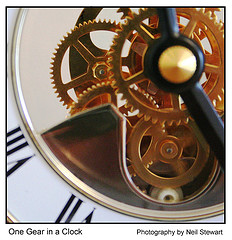Brake Fluid and Nano Lube = Clock Repair Magic!
by Gus Searcy
(Yorba Linda, CA)
First a little background:
I have a Howard Miller Grandfather Clock which I bought new in 1981. It was serviced and oiled professionally in 1992. No other service of any kind has been performed since (yes I know that is not proper way to take care of a clock).
It has a - UW03049B -Urgos Movement.
A couple of weeks ago it stopped ticking and despite my efforts to re-balance and level the clock (I live in California where there was an earthquake recently) it would only tick for a few minutes and then stop.
Please keep in mind as I described the following I am not a clock person of any kind, I don't know the names of parts, the terminology or the proper phraseology, so please excuse me.
I called the local clock repair shop. The owner is knowledgeable (at least I thought so) and he repaired my cuckoo clock for me in the past. He charged me $50.00 for a service call, came to my house, looked at the clock and within in seconds of inspection said the movement was defective and had to be replaced.
This is because the Duma-hickey that connects to the whatch-a-ma-call-it was a very poor design. There was also a lot of metal on metal wear, he said.
He went on to say that the movement could not be saved and I had to buy a new movement which would be $1000 plus $200 in labor, he then paused and said that's if I do it today, because prices are going up!
Fortunately for me I do not yield to such sales tactics.
So I told him no, paid him the $50.00 and as soon as he left went on the Internet.
The first thing I found was I could get a new movement for about $704. Also according to the factory, that movement had a life expectancy of about 20 years.
Given that without proper maintenance it had lasted for over 30 years I didn't feel there was anything defective about the movement.
So I figured at this point my movement was trashed and I had nothing to lose in trying to fix it myself.
So I went on the Internet again and searched "how to clean a clock
"Take the movement out of the case. Take it outdoors and wash it down thoroughly with a spray can of brake cleaner from the auto store, spraying it into all the crevices. Dig out around the pivots with a sharpened toothpick, to remove as much crud as possible. Dip an old toothbrush in Coleman fuel and scrub down everything you can reach. Don't dunk it. Let it dry. Put a toothpick-dab of light oil on each of the pivots and nowhere else. Drip a few drops into each of the mainspring barrels."
I thought this sounded too easy and could it possibly work? I knew how brake fluid cleaner worked and could find no flaw in the logic so I thought, why not try! After all, in my mind, the movement was already trash anyway.
So I followed the directions as stated above and was amazed by the amount of gunk and junk I was able to remove from the movement. Now, with all the oil and gunk removed I had to figure out the best way to get the movement re-oiled. Remembering what clock man said about the metal on mental wear your regular lightweight oil may not be sufficient. So back again I went to the Internet and discovered something called " Nonolube".
According to the advertisements by the various companies Nonolube was more than just an oil. Somehow it had microscopic diamond ball bearings (don't shoot the messenger I'm just stating what I read) that helped metal on metal friction be greatly reduced. Price for a bottle of this magic potion was $16.00 and I figured "What the heck", so I got it. The day it arrived I again when back to the Internet and looked up "how to oil a clock movement" (and have I told you how much I love You-Tube?). Following the instructions I applied the Nonolube in all the recommended locations.
With all of that accomplished I reassembled the grandfather clock. "Holy mother of God, weapons of mass destruction, it work"!
It is working to this day and keeping perfect time. I'm writing this post so that it may give some other person the confidence to try this cleaning and oiling approach before giving up on the movement.
My total investment was about $26.00 and 3 hours of time.
I hope this helps.
Gus Searcy
Comments for Brake Fluid and Nano Lube = Clock Repair Magic!
|
||
|
||
|
||
|
||
|
||


